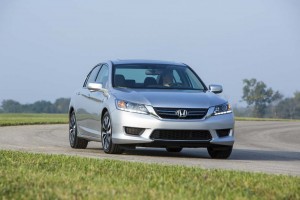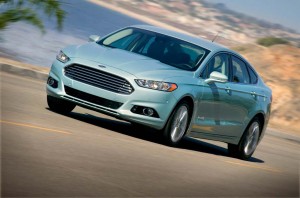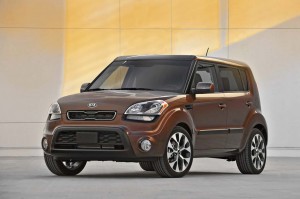The 2014 Honda Accord Hybrid is the latest among a growing list of gas-electric models to take hits for what critics contend are overly optimistic and misleading mileage claims.
It’s not the first time Honda has been faulted for its hybrid mileage ratings – an estimated 47 mpg on the 2014 Accord version – but it’s far from alone, Ford last year lowering its own numbers for the Fusion C-Max that initially also had a 47 mpg rating.
But most manufacturers have been sticking by their fuel economy numbers, which are based on testing by the Environmental Protection Agency, despite concerns that the industry has been “gaming” the system by tuning vehicles to maximize results in those tests while delivering lower results in real-world driving.
“We’ve found that the EPA tests often exaggerate the fuel economy of hybrids,” said Jake Fisher, director of automotive testing for Consumer Reports.
In its own test of the 2014 Honda Accord Hybrid, the influential magazine found that the gas electric model – priced from $29,155 to $34,905 — averaged just 40 mpg in the EPA Combined cycle, a full 7 miles per gallon below the figure on its Monroney, or window, sticker.
That discrepancy can work out to a significantly higher annual fuel bill. At 47 mpg, a typical motorist clocking 15,000 miles a year would expect to burn around 320 gallons annually. At $4 a gallon that would work out to around $1,280. Reduce fuel economy to 40 mpg and the same vehicle’s annual gas consumption would jump to 375 gallons, and a total bill of around $1,500.
(Stable fuel prices lead to big shift in the cars consumers are buying. Click Here for the story.)
The higher costs of operation could might make a big difference, especially if a buyer were considering the standard, 4-cylinder version of the Accord, starting at just $21,955. Shoppers generally are motivated by two factors when opting for a hybrid, the emotional benefits of helping the environment, and the more practical advantages of saving fuel.
This isn’t the first time Honda has taken shots for its hybrid mileage ratings. A dispute with one owner of an older Civic version turned into a major news story when she took the case to small claims court and won – before the verdict was tossed out on appeal. But Honda then reached settlement in a close action dispute.
Other automakers have had similar problems. Consumer Reports noted in 2012 that there was a wide disparity between the mileage ratings for the Ford Fusion and C-Max hybrids and what the magazine’s test results indicated. In fact, Ford was sued by several consumers because of that gap. The maker last year announced it would reduce its stated mileage on the C-Max hybrid to 43 mpg.
Automakers don’t deny there can be a gap between their mileage ratings and real world performance. They routinely defend the continued use of questionable numbers, asserting that they must match the EPA test results. In fact, the federal agency’s rules allow a manufacturer to state any figure as long as it is no higher than what the EPA achieved in its test procedures.
(Toyota counting on new diamond-like material to boost hybrid mileage up to 10%. Click Here for the story.)
Industry watchers have repeatedly noted that hybrids tend to have a much wider gap between EPA test results and real-world experience indicates. That appears to be the result of how hybrids operate. They are designed to regenerate energy normally wasted during braking or coasting, storing it in a small, onboard battery pack. That power then can assist during launch or acceleration.
But the technology is particularly sensitive to road conditions and driving behavior. So, while “hyper-milers” may achieve even better numbers than a maker promises, most motorists are likely to see lower fuel economy.
Hybrids aren’t the only vehicles that have taken heat for questionable mileage, however. A number of vehicles from Hyundai and Kia routinely fell short several years ago, and it was eventually revealed the Korean carmaker had fudged internal tests that are often relied on by the EPA. Both Hyundai and Kia had to restate mileage on a wide variety of models, the Kia Soul, for example, losing 6 mpg off its original rating.
The makers wound up paying a steep federal penalty, settled costly legal actions and provided financial relief to owners of the products to cover their higher operating costs.
(Hyundai restates mileage for new Sonata. Click Here for the story.)




It’s Monroney sticker, not Munroney sticker.
And yes, I DO know that. Gotta get my fingers to listen!
Paul E.
The EPA test is a reference point. Yes ALL auto makers tune their cars to get the best EPA ratings since this is a selling point and they’d be foolish not to.
The EPA has failed consumers but not educating people that the EPA mpg rating is simply a reference point based on what the EPA deems to be typical driving patterns. Tests have shown that driving style can alter the mpg figures by as much as 30%. So you can have the majority of people who get close to the stated mpg +/- and others who gets 30% less due to the manner in which they drive.
There is no possible means to compensate for the driver who gets 30% less mpg unless the car makers are forced to grossly under-rate the true mpg of their products – which would be ignorant just like the Obama and EPA mandated 54.5 mpg figure pulled from their orifice.
Point of accuracy. There was no change in Fusion Hybrid mileage ratings. The change was for the C-Max, a hybrid-only product line, due to use of Fusion data for the same drive train and weight class, as allowed by the EPA. Increased cross sectional area of the mini-SUV” C-Max body causes it to shortfall the performance of the sedan-bodied Fusion.
Have fun,
Frank
We stand corrected, Frank.
Paul A. Eisenstein
Publisher, TheDetroitBureau.com